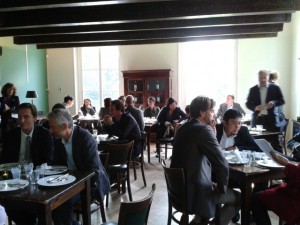 I’m live blogging today from an international seminar organized by GO-SPOOR, a community of research and practice that brings together the main payers in TOD in The Netherlands. GO-SPOOR is the overarching framework within which my postdoc project, iTOD (implementing TOD), is located. Today’s program includes presentations by researchers on the North Wing (Amsterdam-Utrecht) part of the project, the South Wing (Rotterdam-Den Haag) part, as well as discussions led by international experts:
I’m live blogging today from an international seminar organized by GO-SPOOR, a community of research and practice that brings together the main payers in TOD in The Netherlands. GO-SPOOR is the overarching framework within which my postdoc project, iTOD (implementing TOD), is located. Today’s program includes presentations by researchers on the North Wing (Amsterdam-Utrecht) part of the project, the South Wing (Rotterdam-Den Haag) part, as well as discussions led by international experts:
- Gebhard Wulfhorst (Technische Universitat Munchen)
- Michael Neuman (University of New South Wales)
- Carey Curtis (Curtin University)
- Rachelle Alterman (Technion–Israel Institute of Technology)
- Alain l’Hostis (IFSTTAR)
- David Levinson (University of Minnesota)
But what makes this seminar different is that we’ll be travelling to different cities to see their TOD approaches: starting in Arnhem, then off to Den Haag tomorrow and Zaandam on Saturday.
Karst Geurs (University of Twente) introduced the South Wing iTOD project by discussing StedenbaanPlus, a major agreement between regional and local authorities (municipalities, transportation planners, regional governments) to improve the accessibility through development around transit. The idea is to generate development around stations to generate more passengers on the rail network. StedenbaanPlus is unique in The Netherlands because it takes a regional approach to TOD–other projects in the country have been very focused on the areas immediately around railway station, and development was in a sporadic pattern. The project will add about 750,000 square meters of office space and from 25000 residential units, as well as increasing the quality and frequency of train service (these figures reflect major reductions due to the economic crisis and persistent oversupply of office space). One major problem in The Netherlands is that areas designated for new housing are often in suburban areas outside the reach of transit (the VINEX locations I’ve written about in earlier posts). Another area of uncertainty is that Netherlands Rail has not yet agreed to the increased rail frequencies. At this point rail ridership has increased while bus ridership has decreased. Karst’s postdocs Lissy la Paix Puello, Christa Hubers, and Martijn Droes gave more in-depth presentations on the economic effects of TOD. Christa is trying to determine whether two-person households who live near TOD actually use transit, and we had a lively discussion about the low rate of public transit by the Dutch (9% compared to the European average of 17%) and whether the built environment in newer residential developments is desirable.
Luca Bertolini (University of Amsterdam, my supervisor) gave an overview of the North Wing iTOD project, highlighting the fact that while TOD isn’t new in The Netherlands, Amsterdam doesn’t take a regional approach to the integration of land use and transportation. Erwin van der Krabben (Radboud University Nijmegen) gave the Arnhem-Nijmegen context. The project examines “smart governance” and finance strategies in TOD, including urban land readjustment which he discussed in more detail. The postdocs on the North Wing iTOD project (me, Dorina Pojani, and Sander Lenferink) presented our work to date on the project, mine on transferrable lessons from a meta-analysis of case studies in 11 cities, Dorina focusing on policy transfer between countries/cities and government officials and Sander discussing whether value capture tools in TOD can be transferred to The Netherlands. Dorina has done extensive interviews with Amsterdam and international TOD planners to ask them how they learned from other cases and what types of policy transfer happens. Sander has found that Tax Increment Financing, for example, is legally and financially possible in The Netherlands, but the application involves political choice (e.g. at the expense of other services); the consequences of these strategies are still unknown in this country. Ary Samsura also presented on applying gaming approaches to land and property development; this is part of the work on value capture. Sander, Dorina, and I recently presented our work at the ACSP/AESOP conference in Dublin.
We’re looking forward to seeing the real-world examples in the next couple of days!
